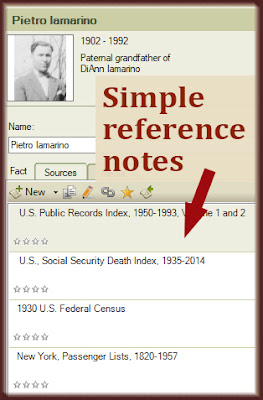Even if your ancestors didn't emigrate to the United States, U.S. immigration laws may have influenced their journey.
When my first ancestor left Italy and made the 3-week voyage to New York City in 1890, all he had to do to seek out a better life was:
- Have somewhere and someone to go to
- Not be Chinese
You read that right. In 1882 the U.S. government passed the Chinese Exclusion Act, banning Chinese laborers from coming ashore for 10 years. The many Chinese workers already in the U.S. were not allowed to become citizens.
My many ancestors who came to America had no restrictions. They were not Chinese, they were healthy, and other relatives or friends had paved the way for them, helping them get jobs and a place to live.
 |
| Immigrants poured into Ellis Island by the boatload, all day, every day. |
Before my second ancestor came here, there was the 1891 Immigration Act. There were more and tougher restrictions. Immigrants had to:
- Not have a contagious disease
- Not be a polygamist
My people came right on in.
My two grandmothers were born in New York to recent Italian immigrants. But before my 2 grandfathers arrived, there was the Immigration Act of 1903. This was a big crackdown. For my grandfathers to come into New York, they had to:
- Not be anarchists
- Not be beggars
- Not be pimps
Again, no problem for the average impoverished human looking for a better life.
The next big immigration reform was the 1917 Immigration Act. My grandfathers and other relatives had to:
- Not be Asian, but the Philippines and Japan were OK
- Be able to read any one language if you were over the age of 16
You may be noticing an anti-Asian pattern. My husband's grandparents all arrived from Japan with excellent timing. Only the Chinese ban was in place.
 |
| Some workers, like my great grandfather, came to earn money, went home, and did it again. |
In 1921 the immigration laws began playing with quotas. They looked at the 1910 U.S. Federal Census to see how many foreign-born people were here, and where they were from. The quota for who could come to America was 3%. If there were 100,000 Romanians in America, 3% of 100,000 would be allowed in. If there were 200,000 Pakistanis in America, 3% of 200,000 would be allowed in. If there were 100 people from India, 3 Indians would be allowed in.
This had little or no effect on Europeans, though, because the Western Hemisphere was excluded from the nationality quota. Still, there was an immigration cap of 350,000 people.
But don't be Asian.
The Immigration Act of 1924 slashed the immigration cap to 165,000 people, dropping the nationality quota to 2%, but basing it on the 1890 census, not the 1910 census. Asians were still barred and were not eligible to become U.S. citizens.
Things stayed this tight with no changes until the Bracero Agreement in 1942. But that only effected you if you were a Mexican national coming here as a temporary agricultural worker. In 1943 the Magnuson Act open the door just a crack for the Chinese. They were allowed to naturalize and 105 new Chinese immigrants would be allowed in.
I'm not going to go much further because most of my readers are researching their grandparents. But in 1952 the Immigration and Nationality Act:
- Stopped excluding races (Asians)
- Changed the quotas to one-sixth of 1% of each nationality based on the 1920 census
- Gave preference to skilled immigrants and family reunification
It was this 1952 immigration law that caused an entire branch of my family to go to Canada instead of America. They had family here, but the quotas were too small. They had to turn north. Now there's a big enclave of my fellow Colle Sannita descendants in Niagara Falls, Canada.
Do you have ancestors who came to America, but their brothers didn't? Maybe they went to Brazil, Canada, Australia or England? It's very possible the U.S. immigration laws and quotas played a big part in that decision.
For an interactive timeline of U.S. immigration laws, see the Pew Research Center website. And see a wonderful video about Ellis Island on History.com.
And speaking of immigration:












